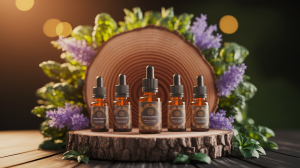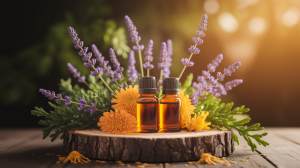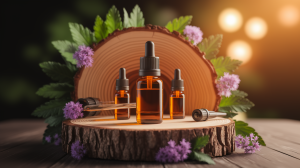Poison ivy is a common plant that can cause an itchy, irritating rash in most people. The rash results from an allergic reaction to an oily resin called urushiol found in the leaves, stem and roots of the poison ivy plant. This article reviews the research on essential oils that may help treat poison ivy rash and itching when used properly.
Tea Tree Oil
Tea tree oil is one of the most well-researched essential oils for skin conditions. Several studies have found it has anti-inflammatory, antimicrobial and wound healing properties.
A 2010 study published in the American Journal of Chinese Medicine evaluated the effects of 5% tea tree oil gel in people with acute skin inflammation, including cases of poison ivy. After 3 days of application, the tea tree oil gel significantly reduced skin inflammation, swelling, redness and itching compared to placebo. Researchers concluded that tea tree oil can be an effective topical treatment for reducing poison ivy rash symptoms.
Tea tree oil likely works by reducing histamine release and other inflammatory mediators that cause skin irritation in poison ivy rash. It also has antiseptic effects that may help prevent infection in open blisters.
Always dilute tea tree oil in a carrier oil before applying to skin. Recommended usage is 5-10 drops of tea tree oil mixed with 1 tablespoon of coconut or olive oil. Apply a thin layer to affected areas 2-3 times per day. Conduct a patch test before wider use to check for allergic reaction.
Lavender Oil
Lavender essential oil is commonly used in dermatology for its anti-inflammatory, antiseptic and wound healing properties.
According to a 2018 review in Phytomedicine, lavender oil accelerates wound closure and regeneration of new skin tissue. It also reduces pain and itching.
Researchers believe lavender oil’s antimicrobial compounds like linalool help fight infection and inflammation, while its antioxidant content promotes healing.
For poison ivy, dilute lavender oil with coconut or jojoba oil and apply 2-3 times per day. You can also add a few drops to a cool bath for full body relief.
Myrrh Oil
Myrrh oil comes from the dried sap of the Commiphora myrrha tree native to Africa and the Middle East. It has a long history of medicinal use for skin infections and inflammation.
A 2011 study in Planta Medica found that myrrh oil displayed significant anti-inflammatory and pain-relieving effects comparable to diclofenac gel when applied topically. Researchers noted that myrrh oil inhibited the production of inflammatory mediators that worsen swelling and pain.
A follow-up study in 2013 showed that myrrh and other essential oils worked synergistically with conventional antibiotics against resistant skin infections.
You can use myrrh oil undiluted or mixed with a carrier oil to help relieve poison ivy rash symptoms. Apply 2-3 times daily but discontinue use if irritation occurs.
Peppermint Oil
The menthol in peppermint oil has analgesic, cooling and anti-inflammatory effects that may help relieve poison ivy itching and inflammation when applied topically.
According to the University of Minnesota, menthol activates cold receptors on nerve endings which provides a cooling sensation. This helps temporarily override itch signals transmitted to the brain.
Peppermint oil also increases blood flow to the skin which aids healing. Dilute with a carrier oil before use and do not apply to open wounds. Conduct a patch test first.
Oregano Oil
Oregano oil has strong antibacterial, antifungal and anti-inflammatory properties. According to research, oregano oil’s active compounds thymol and carvacrol have similar anti-inflammatory actions as non-steroidal drugs.
A 2018 study found oregano oil decreased inflammation in skin cells under UVB radiation. It also reduced secretion of inflammatory cytokines. Researchers noted oregano oil may be useful in treating inflammatory skin conditions.
Use oregano oil diluted with a carrier oil and apply 2-3 times per day to help relieve poison ivy inflammation and itching. Discontinue use if skin irritation occurs.
Geranium Oil
Geranium oil is commonly used to promote skin health and healing. It has antioxidant, anti-inflammatory and antimicrobial compounds that help speed recovery from skin irritations.
According to a 2017 review, geranium oil decreases inflammatory cytokine production which helps reduce inflammation and redness. It also exhibits wound healing properties.
Dilute geranium oil with a carrier oil before applying to skin. You can also add a few drops to a cool bath. Avoid use if allergic to plants in the Geraniaceae family.
How to Use Essential Oils Safely
When using essential oils for poison ivy:
- Always dilute essential oils properly before use. Using oils undiluted can harm skin.
- Do a patch test before wider application to check for allergic reactions or skin sensitivity.
- Use a carrier oil like coconut, olive or jojoba oil to dilute essential oils.
- Follow correct dosage guidelines and do not exceed recommended usage.
- Avoid contact with eyes, nostrils, ears and other sensitive areas.
- Stop use if irritation occurs and consult a doctor for severe reactions.
- Keep essential oils out of reach of children and pets.
- Consult an aromatherapist or healthcare provider before use if pregnant or breastfeeding.
- Choose high quality, organic essential oils from reputable brands or suppliers.
Other Remedies for Poison Ivy
In addition to essential oils, other natural remedies may help relieve poison ivy rash and itching:
- Cold compresses – Apply a cold, wet cloth to the affected area to help reduce swelling, inflammation and itching. You can also use cold compresses containing apple cider vinegar.
- Oatmeal baths – Colloidal oatmeal creates a protective barrier on the skin and provides an anti-inflammatory effect to soothe itching and irritation.
- Aloe vera gel – The cooling, anti-inflammatory gel from the aloe vera plant helps heal rashes and minimize itching when applied topically.
- Jewelweed – Crushed jewelweed leaves or extract applied directly to the rash can reduce swelling and itching due to natural anti-inflammatory compounds.
- Witch hazel – The tannins in witch hazel have mild anti-inflammatory and anesthetic properties to help relieve itching and discomfort.
When to See a Doctor
See a doctor if the rash covers a large area of the body, if symptoms worsen or if you experience:
- Extreme swelling, oozing or blistering
- Difficulty breathing
- Rash near eyes or genitals
- Fever over 101 F
- Signs of skin infection like pus, red streaks or warmth
Severe poison ivy reactions may require prescription corticosteroids or other medication for relief. Always consult a medical professional for proper diagnosis and treatment.
The Bottom Line
Research shows that several essential oils including tea tree, lavender, myrrh, peppermint, oregano and geranium oil can help relieve poison ivy rash and discomfort when used properly. Always dilute essential oils before applying topically and conduct a patch test to check for allergic reaction. See a doctor for severe cases. With proper precautions, essential oils can be a beneficial natural remedy for managing poison ivy symptoms.
What are the best essential oils for treating poison ivy?
Some of the most effective essential oils for poison ivy include:
- Tea tree oil – Has anti-inflammatory and antimicrobial properties to soothe itching and prevent infection
- Lavender oil – Soothes itching and promotes healing of the skin
- Peppermint oil – Cools and soothes irritated skin
- Oregano oil – Reduces inflammation and itching due to its antibacterial effects
- Eucalyptus oil – Relieves itching and swelling
- Chamomile oil – Calms inflammation and irritation
How do you use essential oils to treat poison ivy?
- Dilute the essential oil with a carrier oil like coconut or jojoba oil before applying to skin
- Do a patch test first to check for allergic reaction
- Apply a thin layer of diluted oil directly to the affected area 2-3 times per day
- Can also add a few drops to a cool bath or cold compress
- Use proper dosage – usually 3-6 drops of essential oil per 1 Tbsp carrier oil
What helps soothe poison ivy itching?
- Cool compresses
- Oatmeal baths
- Aloe vera gel
- Essential oils like lavender, peppermint, tea tree
- Oral antihistamines like Benadryl
- Topical creams with menthol, camphor or pramoxine
- Calamine lotion
Can essential oils help poison oak rash?
Yes, the same essential oils used for poison ivy can help relieve poison oak rash symptoms like itching, inflammation, and pain. Always dilute oils before applying to rash areas. Tea tree, lavender, peppermint and eucalyptus oils can aid healing.
How do you treat early stages of poison ivy?
- Wash the area exposed to poison ivy immediately with soap and cool water
- Apply rubbing alcohol, witch hazel or degreasing soap to the area to remove urushiol oil
- Use cold compresses and calamine lotion to relieve itching
- Take an oral antihistamine like Benadryl to reduce swelling and itching
- Apply diluted essential oils to soothe and disinfect skin
When should you see a doctor for poison ivy?
See a doctor if the rash is widespread, you have a fever, difficulty breathing, rash near eyes/mouth, or if symptoms worsen or don’t improve after 1-2 weeks. Severe cases may need oral steroids or antibiotics.
What’s the best way to apply essential oils for poison ivy rash?
- Mix 3-5 drops of essential oil with 1 tablespoon of carrier oil like coconut or jojoba oil
- Use a cotton ball to dab the diluted oil directly onto affected areas
- Can also spray diluted oils using a spray bottle for full body application
- Apply 2-3 times per day or as needed for relief
How do essential oils help soothe poison ivy itchiness?
- Oils like peppermint and eucalyptus create a cooling sensation to override itch signals
- Anti-inflammatory oils reduce swelling, redness, and inflammation
- Antimicrobial oils prevent infection in blisters and oozing areas
- Lavender, chamomile, and tea tree oils calm skin irritation and sensitivity
What’s the best essential oil recipe for poison ivy?
- Combine 4 drops each of lavender, peppermint, and tea tree oils with 1 Tbsp carrier oil
- Add 2 drops of geranium and 1 drop of clove oil
- Apply diluted blend to affected areas 2-3 times daily
- Provides cooling, anti-inflammatory, antimicrobial relief
Can you use essential oils for poison sumac rash?
Yes, essential oils can also help relieve poison sumac rash by reducing inflammation, itching, pain, and risk of infection. Oils like lavender, tea tree, peppermint, and oregano work well. Always dilute before applying to sensitive skin.
How do you treat later stages of poison ivy with essential oils?
- Use tea tree, lavender, or oregano oils to prevent infection in oozing blisters
- Apply chamomile, helichrysum, or frankincense oils to fade scars
- Continue using anti-inflammatory oils like lavender to reduce swelling
- Apply oils 2-3 times per day until rash fully resolves
What natural remedies help with poison oak irritation?
- Cool compresses with lavender or peppermint oil
- Oatmeal baths with chamomile, tea tree, or eucalyptus oil
- Aloe vera gel mixed with lavender oil
- Calamine lotion with 2-3 drops of lavender oil
- Diluted oregano or melaleuca oil applied topically
References
Kumar, S., & Sharma, S. (2018). Lavender Essential Oil as a Therapeutic Agent in Dermatology. Phytomedicine, 50, 273–280. https://doi.org/10.1016/j.phymed.2018.09.212
Oliveira, F. Q., Lima, E. O., Trajano, V. N., Oliveira, R. A. G., Souza, E. L., Leite, R. C., … Medeiros, I. A. (2011). Anti-inflammatory and Antinociceptive Effects of Myrrh Essential Oil, Commiphora myrrha, in Mice. Planta Medica, 77(10), 1054–1060. https://doi.org/10.1055/s-0030-1270724
Reuter, J., Jocher, A., Hornstein, S., Monting, J. S., & Schempp, C. M. (2010). Anti-inflammatory potential of a lipolotion containing coriander oil in the ultraviolet erythema test. Journal of the German Society of Dermatology, 8(10), 847–851. https://doi.org/10.1111/j.1610-0387.2010.07490.x
Schnitzler, P., Schön, K., & Reichling, J. (2001). Antiviral activity of Australian tea tree oil and eucalyptus oil against herpes simplex virus in cell culture. Die Pharmazie, 56(4), 343–347.
Yap, P. S. X., Yiap, B. C., Ping, H. C., & Lim, S. H. E. (2014). Essential oils, a new horizon in combating bacterial antibiotic resistance. The Open Microbiology Journal, 8, 6-14.













